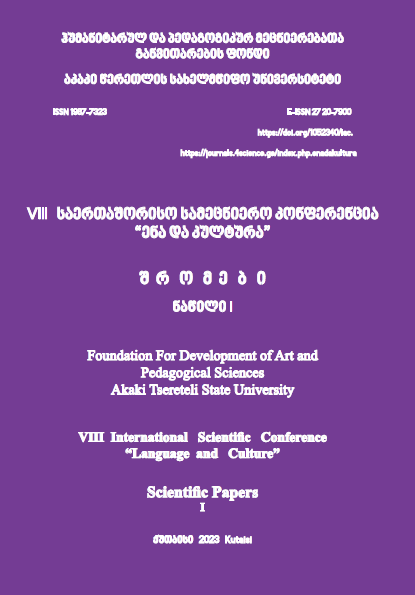Kulashi Seen Through the Eyes of the Georgian Jews (Abraham Sapir’s “Kulashi: What I Have Seen, Heard and Experienced”)
DOI:
https://doi.org/10.52340/lac.2023.08.26Abstract
It is widely known that Jews have lived in Georgia from time immemorial. Later, as a result of external and internal migration waves, the Jewry spread all over Georgia. Kulashi Jewry stands out from the rest of the Georgian Jewish diaspora due to its unique local color and large concentration in one small location. Kulashi is also distinguished by the fact that it has been one of the most important religious and spiritual centers for the Georgian Jews over decades. It should be particularly emphasized that: a) Historical sources say that Kulashi synagogue is the oldest one among the Jewish shrines in Georgia. According to the historians, it dates back to the 18th century; b) it was the only settlement in the entire Soviet Union inhabited in a certain period by the Jews exclusively; c) the traditional occupation of Kulashi Jewry, like that of Georgian Jewish community in general, was trade but it was somewhat different from other regions. The study of the primary materials has demonstrated that there is almost no information about Kulashi Jews either in the historical sources or in travelogues and travel diaries. Therefore, the significance of the study of Georgian printed products issued in Israel and containing rich information can hardly be overestimated. In particular, the present paper is concerned with Abraham Sapir’s book “Kulashi: What I Have Seen, Heard and Experienced”. The book provides consistent and accurate description of the life of Kulashi Jews. It can well serve as a primary and reliable source for the study of various social and cultural aspects of the Kulashi Jewish community, including demographic data, the origin of Kulashi Jews, their trade, political engagement, religion, synagogues etc. The book is marked with genre diversity and original narrative style, much of which consists of dialogues formatted as a series of interviews. The book is supplemented by lots of photos, tables and maps. The whole epoch is represented through the generalized individual stories. The interviews with numerous respondents cover all areas of Kulashi Jews’ life, offering the reader either firsthand accounts or the stories heard from someone with knowledge of an event and/or topic. The present paper discusses in detail Abraham Sapir’s book “Kulashi: What I Have Seen, Heard and Experienced” that provides very interesting and useful information as well as documentary materials for the study of the life and occupation of Kulashi Jews. The book enables us to explore their identity and gain deep insight into the reality of a specific epoch.
Downloads
References
• ცური მარიო, მსოფლიოს ქართველი ებრაელები - კულაში:
/https://m.facebook.com/groups/309989872702198/permalink/783663165334864
• ბერიძე ირინე, ქართველი ებრაელების ისტორია დაბა კულაშში: https://netgazeti.ge/news/231253/
• დიდი ალიის დასაწყისი: http://www.georgianjews.org/stat.php?id=115&lang=gr
• სინაგოგა დაბა კულაში: https://garbge.wordpress.com/2011/05/02/kutaisi-18/
• ნიკოლეიშვილი, ა., აბრამ საპირის ბიოგრაფია: http://abraamsapir.com/themes/default/assets/vendor/pdfjs/web/viewer.html?file=http://abraamsapir.com/storage/app/uploads/public/5b0/d99/420/5b0d9942063bc254485360.pdf









